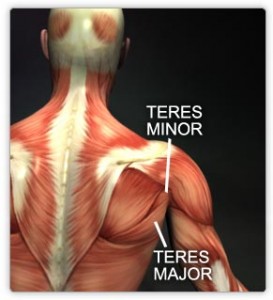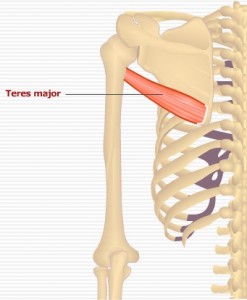Having problems moving your hand backwards and tucking the back of your shirt into your jeans? It may be due to an injury to the Teres Major, one of the major muscles in the body. Read on to know all about Teres Major.
Teres Major Definition
Page Contents
Teres Major is one of the most important muscles of the shoulder and the upper arm. It lies behind Latissimus Dorsi, a broad flat muscle present on either side of the back. In humans, just ahead of Teres Major Latissimus Dorsi is positioned. Teres Major is separated from the Latissimus Dorsi by a small fluid-filled sac known as “bursa” in medical terms.
Teres Major is one of the six humerus muscles. The other muscles are the four Rotator Cuff muscles and the Deltoid muscle.
Teres Major Location

Picture 1 – Teres Major
Source – deeptissue.com
Humerus is the point of Teres Major insertion origin. Teres Major originates on the inside of the lower part of the scapula, either of the two flat, triangular bones present on either side of the human shoulder.
Where does the Teres Major Insert?
Teres Major inserts at the middle region of the opposite side of humerus of the upper arm, or the bone extending from the shoulder to the elbow.
What does Teres Major do?
What does the Teres Major do? There are not one but three Teres Major functions. These are
Adduction
The Latissimus Dorsi is a broad flat muscle present on each side of the back. Teres Major helps the Latissimus Dorsi to draw the raised upper arm downwards to the body and backwards.
Internal Rotation
It also helps rotate the upper arm in a middle position.
Extension
Teres Major helps extend the upper arm when the arm is in a flexed position. It assists in stabilizing the shoulder joint.
Teres Major Injuries
Teres Major injury can happen due to various conditions such as
Tear
Extreme pressure can result in a Teres Major tear. This can cause pain and impair activities that require backward or sidewise arm movement. Teres Major tear is common during exercises. It is seen in many professional baseball players.
Strain
Teres Major Strain often occurs when proper warm up is not done before workouts. This is less painful than a tear of the muscle and can subside with time and rest. Because of strain in Teres Major bodybuilding professionals often advise proper warm up prior to workouts.
Myopathy
This disease weakens muscles of the body. People affected with Myopathy can suffer from a weakened Teres Major that can hamper proper functioning of the muscle.
Atrophy
This terrible disorder leads to complete wastage of the body muscles and tissues. Wrong way of exercising, lack of exercise, poor circulation and improper nourishment can cause muscle atrophy. Atrophy of Teres Major Muscle can also impair its proper functioning.
Infectious Myositis
Sometimes an infection can result in Myositis or inflammation of the muscles. Infectious Myositis can be a reason behind an affected Teres Major.
Neuromuscular Disease
Many diseases affecting muscles and nerves can reduce their functionality. People suffering from neuromuscular diseases can have diminished Teres Major Muscle function.
Laceration
A blunt injury or trauma on the skin surface can result in irregular wounds and be a reason behind Teres Major Muscle injury.
Contusion
Intense pressure on the upper arm can cause a rupture of blood capillaries and give rise to contusions or bruises. This may in turn affect the performance of Teres Major Muscle.
Teres Major Injury Symptoms

Picture 2 – Teres Major Picture
Though Teres Major helps in most functions involving backward arm movement, there are few cases of its injury. However, an injury to the muscle has been found to produce the following symptoms:
Compactness
An injury to the Teres Major makes sufferers experience a tightness in the region. Affected people feel compactness in the upper arm.
Pain
In people suffering from injury to Teres Major pain is quite common. This usually arises if the muscle is not given rest and no treatment is carried out. The pain is usually dull and intensifies with physical activity.
Swelling
Patients also suffer from inflammation in the affected muscle region. The swelling is not externally visible but can be felt on touching the area.
Loss of functionality
Affected people also begin losing functionality of the Teres Major muscle. This makes activities with upper arm increasingly difficult. Sufferers gradually start losing control over the muscle.
Decreased range of activity
The discomfort and pain in upper arm reduces the range of motion of the arm in sufferers.
Spasms
People affected with Teres Major muscle pain may also periodically suffer from spasms or muscular contraction in the affected area.
Fever
Muscular pain and discomfort can also give rise to fever in some sufferers.
Teres Major Injury Treatment
Most cases of Teres Major Injury heal successfully without surgery. Some of the common ways of treating Teres Major injuries involve
R.I.C.E
Treatment of most muscles injuries begin with the R.I.C.E method. Most health professionals recommend R.I.C.E as an initial therapy. R.I.C.E stands for Rest, Icing, Compression and Elevation.
Rest means stopping activities that require using the affected muscle. Rest is highly necessary for Teres Major pain relief.
Icing refers to application of ice on the muscle to reduce its inflammation.
Compression indicates applying pressure on the region to limit swelling.
Elevation means raising the impaired region over the other parts of the body to reduce swelling.
Warm Up
Teres Major injuries resulting from workouts are usually cured with proper warm-up before exercising. Warm up helps loosen the muscles and tissues and makes them less compact. Flexibility of the muscles helps them stretch and operate more easily.
Strengthening Exercises
For treatment of Teres Major exercises play a vital role. While improper workouts can lead to Teres Major injury, exercises can also help them heal. Teres Major workouts involve strengthening exercises. Teres Major muscle exercises help the upper arm regain its usability. Internal Shoulder Workout is one of the best Teres Major exercises used to strengthen this muscle.
Posture improvement
Improvement in posture also helps faster recovery of Teres Major by putting less pressure on it. Care should also be taken while sleeping to put less stress on the muscle.
Surgery
In cases involving Teres Major rupture, patients suffer huge discomfort and pain. If the symptoms refuse to go away despite therapies, a surgical operation is required for permanent Teres Major pain treatment. However, surgery gives poor outcomes in cases of muscular atrophy.
If you are suffering from upper arm pain and weakness, it is best to stop using the affected area and seek immediate medical treatment. Early treatment can help in curing the condition earlier and prevent it from getting worse.
References:
http://en.wikipedia.org/wiki/Teres_major_muscle
http://www.wrongdiagnosis.com/organ/teres_major.htm
http://ezinearticles.com/?Shoulder-Injury&id=104478
http://www.fitnessuncovered.co.uk/muscle-profiles/teres-major.php
http://www.ncbi.nlm.nih.gov/pubmed/19541846

No Responses